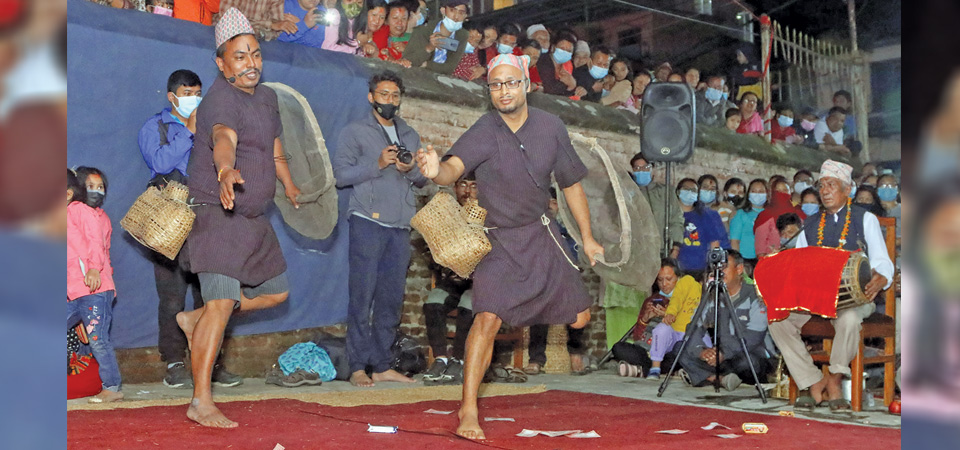Manpower shortage rocks Kirtipur’s Shakti dance

By Aashish Mishra
Kirtipur, Oct. 26: It was around 6 o’clock in the evening on Kojagrat Purnima, Wednesday. Melody filled the air in Tanani, Kirtipur Municipality–10. Sounds of Khin, Taa, Ponga and Jhyali – all traditional musical instruments of Kathmandu Valley – echoed throughout the small settlement near the Bagh Bhairav temple.
Suddenly, five masked figures appeared from the communal building at the central square of Tanani. Bhairav, Indrayani, Brahmayani, Khya and Kawa (Skeleton) came out, meticulously moving their bodies to the exact rhythm of the music playing in the background.
It was the last day of Kirtipur’s Devi Pyakha, the special dance performed once a year during the festival of Dashain to worship Shakti.
Devi Pyakha is the only surviving Shakti dance of Kirtipur, displayed by members of the local Jyapu community, said Bharat Maharjan, a scholar of Nepal Bhasa and Newa culture. He informed that the dance was performed from the day of Nawami to Purnima. “The dance is taken around the entire settlement on Nawami. Then, on Ekadashi, the dance is performed in the Jyapu quarters of Tanani. On Purnima, the dance is performed at a corner of the Chilanchwo Stupa premises near the Jagatpal Mahavihar.
The full-moon day of Dashain – the Kojagrat Purnima – is particularly significant because it is also the birthday of Swayambhu Mahachaitya. “According to the Swayambhu Purana, the iconic stupa of Kathmandu originated on the full moon day of the bright fortnight of Ashwin. Hence, special ceremonies are held in stupas around the valley to mark this day. That is why, on this day, the Devi Pyakha is also performed at one of the biggest stupas of Kirtipur – the Chilanchwo Stupa,” Maharjan, who is a native of the Tanani area, said.
He added, “The corner at which the dance is performed on this day is right in front of a specific house that once belonged to the Guru who taught Kirtipur residents the Devi Pyakha. So, displaying the dance here is a sign of respect to the Guru.”
Another important aspect of the Devi Pyakha is that it bears a noticeable resemblance to the Astamatrika Naach of Patan. This is because the Gurus who originally taught the ballad in Kirtipur were Shakyas and Bajracharyas with marital relations in Patan.
“There are only a few Shakya and Bajracharya families in Kirtipur, many of them related to one another. So, they marry into families from Patan. This means that the Gurus grew up travelling to and from Patan, had their uncles, cousins and in-laws in Patan and were highly influenced by the city’s culture.
This influence is what is visible in the Devi Pyakha.” Nobody knows when the dance began but it is believed that the dance started during the reign of King Pratap Malla in Kathmandu. According to locals, the dance used to be a grand affair attracting visitors from as far as Pharping and Nala. But it started experiencing a decline from the 60s after its lands were acquired by the then His Majesty’s Government for the establishment of the Tribhuvan University. This, coupled with a loss of interest among youths, eventually led to the death of the tradition in the 1990s.
However, following a period of cultural renaissance and at the initiation of the local residents, the dance was revived last year after a gap of more than two decades, Maharjan informed. But, there are still numerous challenges hindering the sustainability of the religious dance. There is a severe lack of funds to organise the dance. As per the organisers, it costs around Rs. 100,000 to stage the dance every night, discounting the cost of maintaining the musical instruments and the costumes. There is also a lack of interested performers, to the point that the absence of one of the current dancers will bring the whole Pyakha to an end.
The Pyakha has also not been able to use the original Ghungroo anklets and the mask of Bhairav since the death of the community elder Hira Lal Maharjan. He who wears the mask must follow strict restrictions otherwise face misfortune. So, no one after Hira Lal has dared to put on the mask.
Nevertheless, Tanani residents are determined to keep this tradition alive, said Dilip Maharjan, vice-chairman of the Tanani Dafaa Khala.
Lending a helping hand is the Kirtipur Municipality which has established a revolving fund of Rs. 1 million. The municipality, at the behest of Aman Maharjan, chairman of Ward No. 10 (where Tanani is located), also constructed the community building at Tanani where the dancers train.
“It is encouraging to see the local government take interest in preserving our culture and identity,” Bharat Maharjan said.
Devi Pyakha is a ballad based on religious stories, folklore and the love story of Lal and Hira. All the stories of the Pyakha are composed in Bir Ras (centred on bravery) except the ‘Ko’ dance which is composed in Hasya Ras (centred on humour).
Recent News

Do not make expressions casting dout on election: EC
14 Apr, 2022
CM Bhatta says may New Year 2079 BS inspire positive thinking
14 Apr, 2022
Three new cases, 44 recoveries in 24 hours
14 Apr, 2022
689 climbers of 84 teams so far acquire permits for climbing various peaks this spring season
14 Apr, 2022
How the rising cost of living crisis is impacting Nepal
14 Apr, 2022
US military confirms an interstellar meteor collided with Earth
14 Apr, 2022
Valneva Covid vaccine approved for use in UK
14 Apr, 2022
Chair Prachanda highlights need of unity among Maoist, Communist forces
14 Apr, 2022
Ranbir Kapoor and Alia Bhatt: Bollywood toasts star couple on wedding
14 Apr, 2022
President Bhandari confers decorations (Photo Feature)
14 Apr, 2022









